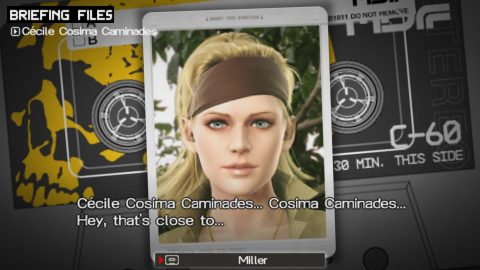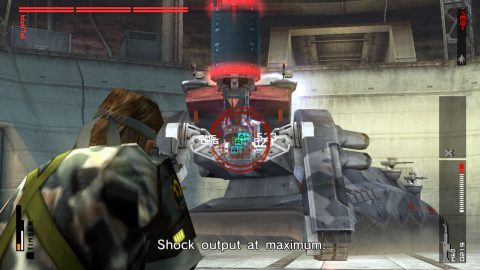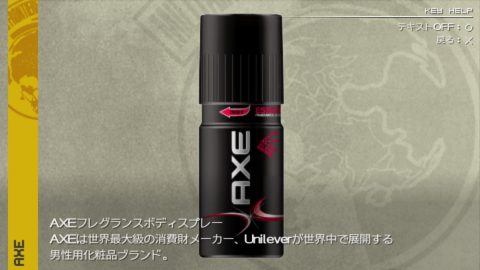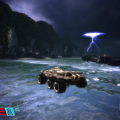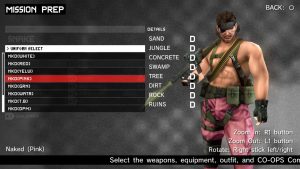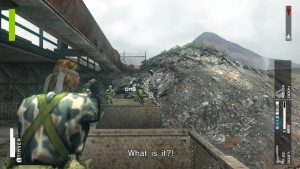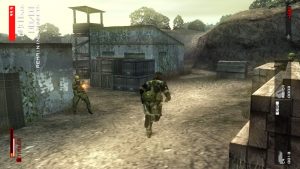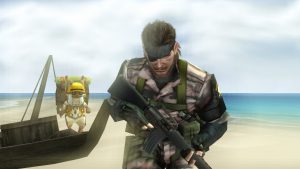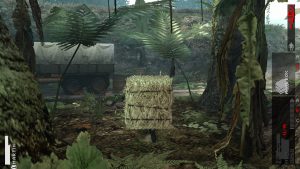- Metal Gear
- Snake’s Revenge
- Metal Gear 2: Solid Snake
- Metal Gear Solid
- Metal Gear Solid Integral Staff Commentary
- Metal Gear Solid (Game Boy Color)
- Metal Gear Solid 2: Sons of Liberty
- Document of Metal Gear Solid 2, The
- Metal Gear Solid: The Twin Snakes
- Metal Gear Solid 3: Snake Eater
- Metal Gear Solid 4: Guns of the Patriots
- Metal Gear Solid: Portable Ops
- Metal Gear Solid: Peace Walker
- Metal Gear Solid V: Ground Zeroes
- Metal Gear Solid V: The Phantom Pain
- Metal Gear Rising: Revengeance
- Metal Gear Touch
- Metal Gear Acid
- Metal Gear Acid 2
- Metal Gear Solid Mobile
The Metal Gear formula, if such a thing exists, had largely been defined early on, with the MSX and PS1 games. Each sequel added its own spin or contribution – the complex detail and presentation of Metal Gear Solid 2, camo and CQC in Metal Gear Solid 3, Metal Gear Solid 4’s dynamic battlefield and action leaning – but largely, each one boiled down to be the same stealth action game that Metal Gear Solid pioneered. Some spin offs had done their own things, like Portable Ops’ soldier recruitment system, but they largely were separate from the main line series. However, in 2010, Metal Gear Solid: Peace Walker shakes up that formula for the first time in the series history, expanding the possibilities of what a Metal Gear game could be.
Peace Walker was announced for the PSP alongside Metal Gear Rising, and both games were heavily insinuated to be Metal Gear Solid 5. For Peace Walker, Kojima initially took up the role of producer, like with Portable Ops, and let others at Kojima Productions have a go at it, but eventually stepped back in as director for the title. The game takes a lot of cues for its design from Portable Ops. The promotional material billed Peace Walker as ‘the missing link’ of the franchise and developers took advantage of the PSP, with an even stronger emphasis on online and co-op than its predecessor. In game cinematics were illustrated by comic book artist Ashley Wood, in the same style as Portable Ops. The name of Big Boss’ army, Militaires Sans Frontières (A Military Without Borders, in English) caused some controversy, given it is a cheeky nod to the real life humanitarian organization, Médecins Sans Frontières or Doctors Without Borders. A disclaimer was added to the game, denying any connection.
The story begins in 1974 with Big Boss and Kazuhira “Kaz” Miller – the same Miller who would help Solid Snake in the future – building their army in Costa Rica. The country, which has no standing military, is invaded by an unknown force who hijack nukes, and Big Boss is called on to discover who’s behind this threat & stop them before it’s too late. Along the way, he meets a cast of mostly new characters like Paz, a 16 year old ‘student of peace’, Chico, an earnest child soldier, Dr. Strangelove, a scientific genius with affections for the Boss, and Huey Emmerich, Otacon’s father. The main antagonist is called ‘Hot Coldman,’ in case there’s any doubt it’s a game directed by Hideo Kojima. The character has no other name, and yet is somehow in a position of power in the CIA.
Peace Walker’s story feels like a direct reaction to criticism of Metal Gear Solid 4. It stays largely out of the way, and ‘the missing link’ part is drummed to be larger than it actually is. The game also dials back some of the more heavy violence & torture it’s traded in the past, receiving a ‘T’ rating from the ESRB in North America and a Cero C rating in Japan. Despite the rating, the game still has the same pitfalls when it comes to women. Paz is introduced as a 16 year old school girl and while her age turns out not to be true, Big Boss can go out on a date with her in a side ops, definitely a creepy look. In the same way, Dr. Strangelove is a cold calculating scientist with a complex back story in desperate need of a better writer. Her name is not only a reference to the seminal film, but also to her romantic attraction to the Boss. Putting aside the uncomfortable insinuations of that, she has the makings of an interesting character, as she becomes Otacon’s mother later on & her relationship to his father is explored here. But the game, instead, chooses to characterize her in some poor ways, like having her skeeve out over Paz’s skin.
Luckily the game plays well, despite the narrative failings. Peace Walker might be on a pint sized system, but it manges to feel just as large as one of the console entries in the series. This is due to the newly added base management. Mother Base is divided up into different divisions – R&D, mess hall, etc. – and each division needs staff to run. Soldiers have stats related to those divisions and the better staffed a division is, with soldiers who are qualified for it, the more efficient it is. This incentives replaying stages to kidnap combatants who are more adept in the areas where the base is deficient. Folks on the base can get into fights or get wounded, requiring a stop at the brig or the infirmary. Snake can also send soldiers and machines out on missions while he’s busy with his own, like Portable Ops, and players even get to build and customize their own Metal Gear, as well. This base does require attention, so for those who just want the stealth action, it can be a nuisance to constantly have to skip through notices and manage it.
This ironically means that Peace Walker feels overwhelming in terms of content, not story, especially for those wanting to complete everything. There’s a lot of missions to work through, lots of weapons, items, & mechs to build, and the final true mission has several elaborate, grindy requirements. It works best in short bursts or with friends, especially on bosses which were designed for groups rather than solo play. Any given stage never feel too long, the game telegraphs what to expect from any mission, and even the smallest amount of progress feeds into resources for unlocking new gear. Each mission starts with a planning stage, where players get to choose a load out. Camouflage returns as part of mission planning, allowing players to chose an outfit they think best matches the challenge before them. With all the items and weapons to unlock, it can be fun to return to an earlier mission with new toys.
While Peace Walker bills itself as a sneaking mission, many missions and boss fights encourage a more direct, action-based approach. Kojima Productions were inspired by Capcom’s Monster Hunter series, something especially evident in the bosses. They have weak points, like fuel tanks or machine guns, that can be exploited or destroyed with good aim, involving strategy, resources, and time to overcome. Camo is still present but Snake can’t change his outfit during the mission, having to choose wisely during planning. Perhaps due to being designed for a portable format from the start, auto aim is just a bit too generous. The PSP was more limited than its console brethren in the control department, but even on the HD ports, Snake pops off super accurately. Luckily, it can be toggled off. Peace Walker’s enemies adapt to Snake’s weapon choices. Enemies will start bringing helmets or blast shields for players using lots of headshots or explosives.
The fun quirks that Metal Gear is know for are still present in Peace Walker. One of the missions involves listening for a bird call in order to find a key card. Hideo Kojima can be recruited for Mother Base. The Fulton recovery system, while based on a real life military system, is given a goofy spin. Despite how often it’s done, the mechanic never fails to be amusing, with soldiers hoisted into the sky with a yelp. Cross promotion returns as well. Snake listens to mission briefings and music using a period appropriate Sony Walkman. Monster Hunter wasn’t only an inspiration for the game; optional boss fights with select monsters from the game are hidden on a secret island, including a monster specially designed for Peace Walker, Gear Rex. In a second crossover with Ubisoft’s series, the Assassin’s Straw Box, an unlockable hay bale that acts like a cardboard box, allows Snake to grab enemies and incapacitate them. The Japanese PSP version got even more cross promotion in the form of branded items. Soldiers can be distracted by Famitsu, instead of a generic magazine. Snake can eat Doritos and toss back a Mountain Dew, while restoring his Psyche with an AXE Body Spray.
Peace Walker debuted on the PSP in April 2010 in Japan, followed by wider release in June of the same year. While taking a hit in resolution and detail, the game manages to capture the look of the PS2 versions just fine, albeit in a smaller scale, and it performs well, despite the sometimes finicky control schemes on the system. In late 2011, the Metal Gear Solid HD Collection released on both PS3 and Xbox 360, including Peace Walker. The HD version of the game reproduced the game at a higher resolution and better performance, but otherwise looks and plays the same. Despite there being a Vita version of the same collection, the game wasn’t included due to the PSP version being backwards compatible with the system and still sold on their digital store.
Nobuko Toda returns to score the soundtrack. Like Metal Gear Solid 4, the game explored its own unique motifs in the absence of the series’ previous theme. “Heaven’s Divide,” the main vocal track, is a brassy tune about fighting for peace, performed by Donna Burke, and another J-Pop styled tune, “Koi no Yokushiryoku,” centers around the character of Paz. VOCALOID synthesizer software was used to create the AI voice for Metal Gear ZEKE. It even hooked into Yamaha’s NetVOCALOID service to allow players to customize the phrases, notes and the voice it used during the game. Unfortunately, this feature didn’t make it into the HD versions.
The series’ genetic makeup changed after Peace Walker. Up to this point, each new game tried to outdo the last one with bigger, more complex set pieces and the introduction of more dynamic gameplay. Peace Walker is a more humble game, focused on smaller, structural changes that make a big impact. It pushed the series in a new direction, and introduced new mechanics, but it remains ever a Metal Gear game with all the positives and pitfalls that come with it. The next pair of games would continue building on the changes Peace Walker introduced, to varying degrees of success.




